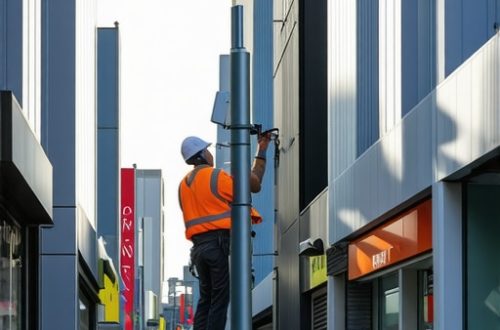
Boost Local Rankings with Proven GMB Signal Repair Techniques in 2024
My Journey into GMB Signal Repair: A Personal Reflection
Hey there! I remember the first time I struggled to get my local business noticed online. It was frustrating, especially when I realized that Google My Business (GMB) signals were the secret sauce I was missing. After diving deep into the world of local SEO and experimenting with various signal repair techniques, I finally started to see real improvements. Sharing this personal journey is my way of helping you navigate the same path with confidence in 2024.
Why GMB Signal Repair Became My Go-To Strategy
Initially, I didn’t understand how crucial signals like reviews, citations, and profile consistency were for local rankings. It wasn’t until I read authoritative sources, like Moz’s comprehensive guides, that I grasped the importance of these signals in establishing trust and relevance. I began focusing on cleaning up inconsistent NAP data and optimizing my profile, which led to noticeable ranking boosts. You can learn more about effective cleanup tips in this GMB cleanup guide.
Proven Techniques to Repair GMB Signals in 2024
From my experience, a few core strategies stand out for boosting local visibility:
- Consistent NAP Data: Ensuring your Name, Address, Phone number are uniform across all platforms is fundamental.
- Addressing Duplicate Listings: Removing or merging duplicates can significantly enhance your local SEO.
- Review Management: Actively collecting and responding to reviews builds credibility and signals trustworthiness to Google.
To streamline this process, I recommend checking out this resource for detailed signal repair strategies. The key is to be systematic and persistent—sometimes, a small tweak can make a big difference in your rankings.
How Do I Know If My Signal Repair Is Working?
It’s a natural question! I’ve found that tracking your local rankings over time with tools like BrightLocal or Whitespark provides clear indicators of progress. I also pay close attention to customer reviews and profile engagements, which are strong signals of local relevance. The process isn’t instant, but with consistent effort, improvements will become evident.
What Are the Biggest Mistakes to Avoid When Repairing GMB Signals?
Great question! One mistake I made early on was over-optimizing keywords or creating fake reviews, which can backfire. Google’s algorithms are increasingly sophisticated and favor authenticity. Instead, focus on genuine customer interactions and profile accuracy. If you want to dive deeper into effective cleanup and signal repair, this article offers excellent insights.
If you’ve experienced successes or setbacks with GMB signal repair, I’d love to hear your story. Drop a comment below or share your tips—let’s learn from each other!
What Are the Hidden Signals That Could Elevate Your Local SEO?
Understanding the subtle yet powerful signals that influence your GMB ranking is essential for any local business aiming to dominate their niche in 2024. Beyond the obvious reviews and NAP consistency, factors such as profile engagement, photo quality, and category accuracy play significant roles. For instance, regularly updating your profile with fresh photos and responding to customer questions can boost your visibility and credibility. These nuanced signals, while often overlooked, are part of Google’s complex algorithm that rewards active and authentic engagement.
How Can You Systematically Identify and Fix Overlooked Signal Gaps?
Performing a comprehensive audit of your Google My Business profile is vital. Use tools like signal repair strategies to pinpoint inconsistencies or missing data that could harm your rankings. Pay special attention to duplicate listings, inconsistent categories, and incomplete descriptions. Addressing these issues methodically ensures your signals align perfectly with Google’s expectations, significantly improving your chances of ranking higher in local searches.
Why Do Some GMB Signals Matter More Than Others in 2024?
In the evolving landscape of local SEO, some signals have gained increased importance. For example, Google now prioritizes local relevance and user engagement over sheer volume of reviews. Engaging with customer reviews by responding thoughtfully can foster trust and demonstrate active management, which Google perceives positively. Additionally, maintaining consistent categories across all online platforms signals niche authority, making your listing more relevant to specific local queries.
Is Your Business Missing the Most Critical Signal for Local Ranking Success?
This question is crucial because many businesses overlook the impact of local citations and profile completeness. Ensuring your citations are accurate and consistent across authoritative directories can significantly enhance your local search visibility. Moreover, optimizing your GMB profile for specific keywords relevant to your business increases relevance and helps Google understand your primary offerings better. For a detailed approach, explore this GMB cleanup guide.
If you’re eager to improve your local rankings, I encourage you to share your experiences or ask questions below. Also, don’t forget to check out more advanced signal repair techniques at this resource to stay ahead of the competition!

Beyond the Basics: Mastering the Intricacies of GMB Signal Optimization
As I delved deeper into my journey of GMB signal repair, I quickly realized that surface-level fixes only scratched the surface of what’s possible. The real game-changer lies in understanding the subtle, often overlooked signals that Google’s algorithm considers crucial. For example, did you know that Google evaluates your profile engagement—such as how often customers ask questions or view photos—as a proxy for your business’s relevance and activity? These signals, while not as obvious as reviews or citations, can significantly influence your rankings when properly leveraged.
One of my most eye-opening experiences was experimenting with photo management. I started regularly updating my profile with high-quality images, responding to customer questions promptly, and even encouraging satisfied clients to share their experiences. The result? A noticeable boost in local visibility and engagement metrics. It’s a reminder that active management and authentic interaction are key components of a comprehensive signal strategy. For a detailed approach, explore this signal repair strategies.
How Do You Prioritize Signals in a Complex Google Ecosystem?
Balancing multiple signals can feel overwhelming, especially with Google’s evolving algorithms. I often ask myself: which signals should I focus on first? Through trial and error, I found that maintaining NAP consistency and actively managing reviews remain foundational. However, as I gained more insights, I realized that category accuracy and profile completeness are equally vital for niche authority. Google’s algorithm increasingly rewards semantic relevance, so aligning your categories and descriptions with your core keywords is essential.
To navigate this complexity, I recommend performing a comprehensive profile audit. This helps identify overlooked gaps and prioritize high-impact fixes. Remember, the key is systematic, consistent effort—think of it as tuning a fine instrument rather than a one-time fix. Over time, these refinements compound, delivering a robust local SEO presence that withstands algorithm updates.
What Is the Role of Local Citations in the Future of GMB Signal Strategy?
One question I often pondered was whether traditional citations still hold weight or if they’re becoming obsolete in the age of Google’s smarter algorithms. The answer is nuanced. While citations alone won’t catapult you to the top, they reinforce your business’s authority and local relevance, especially when consistent across authoritative directories. Recent studies, such as those by Moz, emphasize that citation consistency remains a cornerstone of local SEO success.
In my experience, integrating citations with other signals—like reviews, profile engagement, and keyword optimization—creates a synergistic effect. The trick is to focus on quality over quantity. Ensure your business info is accurate across major platforms, and regularly update your citations to reflect any changes. For a step-by-step process, check out this cleanup guide.
Ultimately, understanding the layered complexity of GMB signals pushes you beyond superficial tactics toward a strategic, data-driven approach. If you’re curious about exploring these advanced techniques or want to share your own insights, I encourage you to comment below. Your experiences could inspire a new perspective or lead to a breakthrough for someone else in the local SEO community.

Deciphering the Algorithmic Enigma: How Do Google’s Subtle Signals Shape Your Local Ranking?
As I’ve delved further into GMB optimization, I’ve come to appreciate that Google’s ranking algorithm functions as a complex, dynamic ecosystem where minute signals carry disproportionate weight. Beyond reviews and citations, factors like business attribute consistency, question and answer engagement, and even photo authenticity metrics subtly influence visibility. Recent research by Moz emphasizes that Google increasingly favors signals indicating genuine, active management—particularly user-generated interactions that foster a sense of community around your listing (Moz’s ranking factors). This realization prompted me to develop a layered approach that prioritizes these nuanced indicators, ensuring my listings resonate with Google’s evolving criteria.
One technique I adopted was systematically analyzing engagement patterns—tracking how often customers ask questions or upload photos—and responding promptly to foster ongoing interactions. Such efforts, although seemingly minor, can significantly enhance your profile’s relevance and trustworthiness in Google’s eyes. This approach underscores the importance of not just fixing visible issues but also cultivating ongoing, authentic engagement, which acts as a powerful signal in the algorithm’s eyes.
Can Advanced Signal Optimization Elevate Your Local SEO Strategy to New Heights?
Absolutely. Incorporating advanced techniques like semantic keyword integration in your profile description and categories can align your listing more precisely with user intent. For instance, rather than generic keywords, embedding long-tail, contextually relevant phrases helps Google understand your niche authority better. This aligns with insights from Search Engine Journal, which highlights that semantic relevance is gaining prominence in local search algorithms (SEJ article).
Another layer of sophistication involves leveraging structured data markup (schema.org) for local businesses. By embedding schema on your website and linking it correctly to your GMB profile, you create a cohesive, machine-readable web presence that reinforces your signals. Such technical optimization, when paired with diligent profile management, creates a powerful synergy that can propel your local rankings to new heights.

What Are the Most Overlooked Signal Gaps That Could Be Sabotaging Your Local SEO?
In my experience, many businesses overlook the significance of profile activity frequency—the regularity with which you update your profile, respond to reviews, or add new photos. Google perceives active management as a sign of a lively, trustworthy business. Neglecting these aspects can cause your profile to stagnate and lose relevance. Additionally, inconsistent category tagging across platforms can dilute your niche authority, making it harder for Google to accurately categorize your business.
To address these gaps, I recommend performing a comprehensive audit akin to what’s detailed in this cleanup guide. By systematically correcting inconsistencies and enhancing profile activity, you reinforce your signals, ensuring they align with Google’s expectations and algorithms.
Engaging in this continuous, layered optimization process transforms your listing from a static profile into a vibrant digital asset that consistently signals relevance and trustworthiness. If you’re eager to dive deeper into these advanced tactics or want to share your own experiences, I invite you to comment below. Let’s push the boundaries of what’s possible in local SEO together.
Things I Wish I Knew Earlier (or You Might Find Surprising)
The Power of Authentic Engagement
Early in my journey, I underestimated the significance of genuine interactions on my GMB profile. Responding thoughtfully to customer questions and encouraging real reviews created a ripple effect that boosted my visibility more than I expected. It taught me that active engagement signals trust and relevance to Google, far more than just accumulating reviews.
The Role of Profile Activity Frequency
I used to think once my profile was set up, that was enough. But I learned that regularly updating photos, posts, and responding to reviews keeps your listing lively. Google perceives active profiles as trustworthy, which can give you a real edge in local rankings.
The Subtlety of Photo Management
Uploading high-quality, relevant images consistently might seem minor, but it significantly impacts how your listing performs. I found that fresh visuals and prompt responses to photo comments helped build credibility and attract more local customers, reinforcing the importance of visual signals in local SEO.
The Overlooked Power of Local Citations
While reviews and NAP consistency are well-known, I discovered that maintaining accurate citations across various directories is crucial. Inconsistent info can dilute your signals, so regular audits and updates ensure your business remains authoritative in Google’s eyes.
The Impact of Semantic Keyword Optimization
Embedding long-tail, contextually relevant keywords into your profile description and categories aligns your listing with user intent. This subtle semantic approach makes your profile more relevant, helping you outrank competitors who rely solely on generic keywords.
Structured Data as a Game-Changer
Implementing schema markup on your website and linking it to your GMB profile creates a cohesive, machine-readable presence. This technical layer reinforces your signals, giving your local SEO efforts a significant boost.
Resources I’ve Come to Trust Over Time
- Moz’s Local Search Ranking Factors: A comprehensive guide that helped me understand the nuanced signals Google considers. It’s an authoritative resource I recommend to anyone serious about local SEO.
- BrightLocal Blog: Regularly updated with actionable insights and case studies, this site deepened my understanding of local ranking dynamics.
- Search Engine Journal: Their articles on semantic relevance and structured data provided advanced tactics that elevated my optimization game.
- Google’s Official My Business Help Center: The best source for platform-specific updates and best practices directly from Google.
Parting Thoughts from My Perspective
Mastering GMB signal repair is a layered, ongoing process that requires a mix of technical know-how and authentic engagement. I’ve realized that the most powerful signals are often the ones you nurture through consistent effort and genuine interaction. If you’re serious about local SEO, don’t overlook these subtle yet impactful factors—they could be your secret to climbing the local rankings in 2024 and beyond. If this resonated with you, I’d love to hear your thoughts. Feel free to share your experiences or ask questions below, and let’s grow our local SEO knowledge together!




